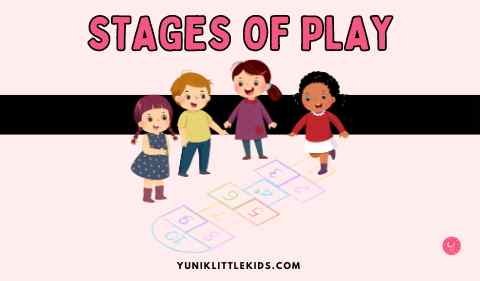
Stages of Play by Mildred Parten – Explained.
What’s Inside:
Details on how playtime helps your child develop social skills through 6 stages of play as said by Parten! Learn tips to encourage each stage for a happy and thriving little one.
Exploring Stages of Play with Your Child
Play isn’t just about giggles and fun (although those are important too!).
It’s a powerful tool that helps children learn and grow in many ways, especially when it comes to social skills.
Psychologist Mildred Parten identified six fascinating stages of play that showcase this social development journey, from exploring on their own to working as a team.
The Stages of Play
Think of these stages as steps on a ladder.
Children typically move through them as they get older. But the pace can vary depending on the child’s individual development.
Here’s a closer look at each stage:
Unoccupied Play (Birth to 3 Months)
Have you ever watched your little one gazing around or just moving their arms and legs in random ways?
That’s unoccupied play!
They’re taking in the world through their senses and figuring things out. At this stage, there’s not much social interaction, but it’s the foundation for future exploration and learning.
Solitary Play (3 Months to 2 Years Old)
Now your child is happy to play by themselves, building magnificent towers with blocks or pushing a beloved toy car around the house.
They’re learning independence, exploring their creativity, and figuring out how things work. While solitary play might seem like they’re not learning social skills, it’s actually an important step.
They’re learning to focus, solve problems on their own, and develop their imagination, all of which are essential for future social interactions.
Onlooker Play (Around 2 Years Old)
This stage is all about observation.
Your child might become fixated on watching other kids playing, soaking it all up and getting ready to participate when they feel comfortable. They might seem shy at first, but their minds are busy absorbing the social cues and dynamics of play.
You can encourage them to join in gently with invitations like “Would you like to build a tower with me?” or simply sit nearby and narrate what the other children are doing.
Parallel Play (Around 2 Years Old and Up)
Here, things get interesting! Your child plays alongside other kids, but not really with them.
This is a stage where you witness two toddlers building towers next to each other, not really working together on the same project. It’s like they’re in their own little play world, but side-by-side with others.
This stage is crucial for developing social awareness. They’re starting to notice and be interested in what other children are doing, even if they’re not quite ready to directly interact.
Associative Play (3 to 4 Years Old)
At this stage, your child starts playing with other kids, sharing toys and ideas. They might take turns pushing a swing or building things together, but there’s not yet a clear goal or plan for their play.
It’s more about the back-and-forth interaction and the joy of playing together. You can provide toys and activities that promote sharing and cooperation, like blocks, dress-up clothes, or board games.
Cooperative Play (4 Years Old and Up)
This is the teamwork stage! Kids work together towards a common goal, like building a giant castle with blocks or putting on a play. They take on different roles, communicate their ideas, and solve problems together.
This stage signifies a significant leap in social development as children learn to negotiate, compromise, and collaborate towards a shared objective.
How a Caregiver Can Aid these Stages?
Knowing about these stages can be a big help for parents, caregivers, and teachers. It helps us understand how children are developing socially and what kind of play activities might be most beneficial at each stage.
Here are some tips on how to use this knowledge to create enriching play experiences for your child:
- For Unoccupied and Solitary Play: Provide safe and stimulating environments for your child to explore. Offer a variety of textures, sounds, and safe objects for them to manipulate.
- For Onlooker Play: Create opportunities for your child to observe other children playing. Take them to parks, playgrounds, or playgroups.
- For Parallel Play: Provide plenty of toys and materials so that children playing alongside each other can explore their own creativity.
- For Associative Play: Offer toys and activities that encourage sharing and cooperation, like blocks, dolls, or board games.
- For Cooperative Play: Encourage imaginative role-playing games or activities that require teamwork, like building a fort or putting on a puppet show.
Summary
Play is Essential for Your Child’s Social Development!
By understanding these stages and providing opportunities for different kinds of play, you’re helping your little one develop the social skills they need to thrive.
From exploring independently to working as a team, play is a crucial part of their social development journey!

